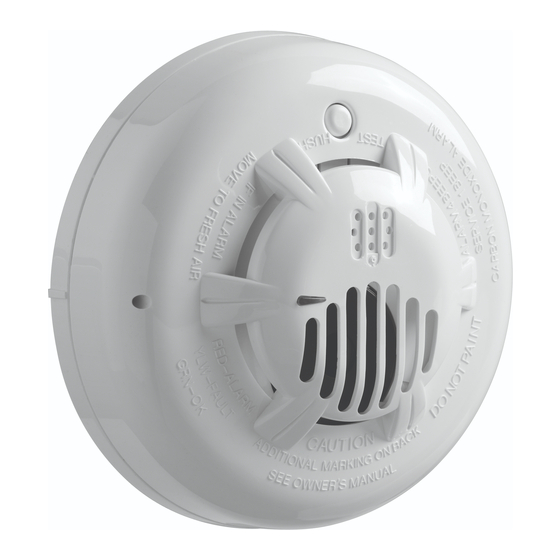DSC PG9933 Installatie- en bedieningsinstructies voor de installateur - Pagina 3
Blader online of download pdf Installatie- en bedieningsinstructies voor de installateur voor {categorie_naam} DSC PG9933. DSC PG9933 9 pagina's. 915mhz wireless carbon monoxide detector

Mounting
The detector can be mounted on a wall or ceiling. For EN approved sites, only ceiling
installation is allowed.
The CO detector must be mounted with its bracket (when it is attached to its bracket
the tamper switch is pressed and the detector automatic reset is performed).
1. Refer to Figure 3 and install using screw locations as required. Maneuver the
mounting bracket so the screws are at the elbow of the screw slots and secure.
2. Fit the detector inside the mounting bracket by aligning it as shown in Figure 3
(detector's alignment notch should be slightly offset from the mounting bracket
tamper release tab), then turn the detector in a clockwise direction until it clicks
into place.
3. Test the detector after completing the installation (as described in the Testing the
Detector section of this manual) and refer to the alarm control panel installation
manual for additional information concerning the use of wireless devices.
Figure 3: Mounting the Detector
Tamper Protection
The PG9933 includes a tamper resistant feature that prevents removal from the mount-
ing bracket without the use of a tool. To engage the tamper resistant feature, cut the
small breakaway tab (marked E in Figure 3) located on the mounting bracket and then
install the detector. To remove the detector from the mounting bracket once it has been
made tamper resistant, insert an appropriate tool into the tamper release opening loc-
ated on the detector housing (marked B in Figure 1). Press and hold while sim-
ultaneously turning the detector counterclockwise.
Owner's Instructions
Testing the CO Detector
NOTE: Performing a CO detector system test will generate an alarm trans-
mission. Notify the central station before testing.
Perform a CO detector system test by pressing the Test/Hush button for a minimum of
6 seconds, the red LED flashes and the sounder emits a temporal 4 pattern.
Perform a CO detector local test by pressing the Test/Hush button for a minimum of 2
seconds, the sounder will emit 2 short beeps.
The following table indicates received signal strength indication.
Green LED blinks
Orange LED blinks
Red LED blinks
No blinks
IMPORTANT! Reliable reception must be confirmed. Therefore, "poor" signal
strength is not acceptable. If you receive a "poor" signal from the device, re-locate it
and re-test until a "good" or "strong" signal strength is received. For UL/UL install-
ations, the test results must be "strong". See the alarm systems installation guide for
detailed diagnostic tests.
Maintenance
Test the detector weekly to ensure proper operation of the detector. When low battery
is indicated (see Table 1 and Specifications) immediately replace the battery. Once a
month, use a vacuum cleaner to keep the air vents free of dust.
E
LED Response
Strong
Good
Poor
Paired, no communication
Reception
